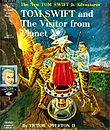
Space Cadet is a 1948 science fiction novel by Robert A. Heinlein about Matt Dodson, who joins the Interplanetary Patrol to help preserve peace in the Solar System. The story translates the standard military academy story into outer space: a boy from Iowa goes to officer school, sees action and adventure, shoulders responsibilities far beyond his experience, and becomes a man. It was published as the second of the series of Heinlein juveniles and inspired the media franchise around the character Tom Corbett, including the 1950s television series Tom Corbett, Space Cadet and radio show which made "Space Cadet" a household phrase whose meaning later shifted in popular culture.
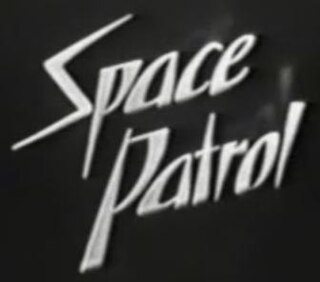
Space Patrol is an American science fiction adventure series set in the 30th century that was originally aimed at juvenile audiences via television, radio, and comic books. It was broadcast on ABC from March 1950 to February 1955. It soon developed a sizable adult audience, and by 1954 the program consistently ranked in the top 10 shows broadcast on a Saturday.

Fawcett Comics, a division of Fawcett Publications, was one of several successful comic book publishers during the Golden Age of Comic Books in the 1940s. Its most popular character was Captain Marvel, the alter ego of radio reporter Billy Batson, who transformed into the hero whenever he said the magic word "Shazam!".

Steve Canyon is an American action-adventure comic strip by cartoonist Milton Caniff. Launched shortly after Caniff retired from his previous strip, Terry and the Pirates, Steve Canyon ran from January 13, 1947, until June 4, 1988. It ended shortly after Caniff's death. Caniff won the Reuben Award for the strip in 1971.
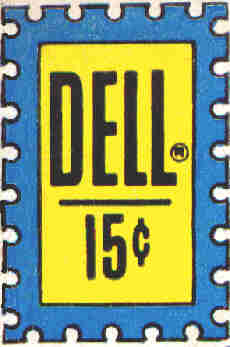
Dell Comics was the comic book publishing arm of Dell Publishing, which got its start in pulp magazines. It published comics from 1929 to 1973. At its peak, it was the most prominent and successful American company in the medium. In 1953, Dell claimed to be the world's largest comics publisher, selling 26 million copies each month.
Twilight Zone literature is an umbrella term for the many books and comic books which concern or adapt The Twilight Zone television series.
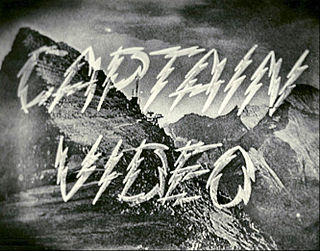
Captain Video and His Video Rangers is an American science fiction television series that aired on the DuMont Television Network and was the first series of its genre on American television.
Joseph Lawrence Greene was an American author of science fiction novels and short stories whose most familiar creations are Tom Corbett, Space Cadet which, in 1951, became a television series popular with young audiences, as well as Dig Allen Space Explorer, a series of six books published between 1959 and 1962, which focused around the adolescent hero Dig Allen and his interplanetary adventures in the genre of boys' juvenile literature. A prolific writer, he also contributed numerous stories to comic books and was an editor, until 1972, for Grosset publishing while writing under a number of pseudonyms including, purportedly, the house pen name "Alvin Schwartz" and also "Richard Mark", and using sundry variations of his own name, which exemplified such foreign-language wordplays for "Green" as "Verdy", "Verdi" and "Vert".
Grosset & Dunlap is a New York City-based publishing house founded in 1898.

Jungle Jim is the fictional hero of a series of jungle adventures in various media. The series began on January 7, 1934, as an American newspaper comic strip chronicling the adventures of Asia-based hunter Jim Bradley, who was nicknamed Jungle Jim. The character also trekked through radio, film, comic book and television adaptations. Notable was a series of films and television episodes in which Johnny Weissmuller portrayed the safari-suit wearing character, after hanging up his Tarzan loincloth. The strip concluded on August 8, 1954.
Paul S. Newman was an American writer of comic books, comic strips, and books, whose career spanned the 1940s to the 1990s. Credited in the Guinness Book of World Records as the most prolific comic-book writer, with more than 4,100 published stories totaling approximately 36,000 pages, he is otherwise best known for scripting the comic-book series Turok for 26 years.
The Eastern Color Printing Company was a company that published comic books, beginning in 1933. At first, it was only newspaper comic strip reprints, but later on, original material was published. Eastern Color Printing was incorporated in 1928, and soon became successful by printing color newspaper sections for several New England and New York papers. Eastern is most notable for its production of Funnies on Parade and Famous Funnies, two publications that gave birth to the American comic book industry.

TidalWave Productions is an independent production studio of comic books and graphic novels. Based in Portland, Oregon, United States, Bluewater publishes biographical comics, adaptations from films, and original titles with self-created characters.
How and Why Wonder Books were a series of American illustrated books published in the 1960s and 1970s that were designed to teach science and history to children and young teenagers. The series began in 1960 and was edited under the supervision of Paul E. Blackwood of the Office of Education at the U.S. Department of Health, Education and Welfare. The series was published by Wonder Books, Inc., a division of Grosset & Dunlap.
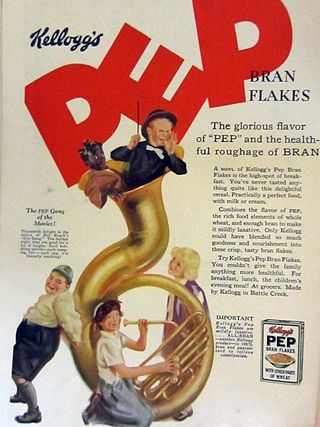
Pep was a brand of whole-wheat breakfast cereal produced by the Kellogg Company, and introduced in 1923, which became the first to be fortified with vitamins B and D in 1938. Pep was a long-running rival to Wheaties, and also the sponsor of Mutual Radio's The Adventures of Superman radio series. One of Pep's advertising slogans was "the Sunshine cereal".
Oskar Lebeck was a stage designer and an illustrator, writer and editor who is best known for his role in establishing Dell Comics during the 1930s and 1940s period known as the Golden Age of Comic Books.

Western comics is a comics genre usually depicting the American Old West frontier and typically set during the late nineteenth century. The term is generally associated with an American comic books genre published from the late 1940s through the 1950s. Western comics of the period typically featured dramatic scripts about cowboys, gunfighters, lawmen, bounty hunters, outlaws, and Native Americans. Accompanying artwork depicted a rural America populated with such iconic images as guns, cowboy hats, vests, horses, saloons, ranches, and deserts, contemporaneous with the setting.
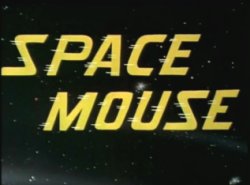
The first Space Mouse is a comic book character published from 1953 to around 1956 by Avon Publications. Space Mouse is also the name of a 1959 Universal Studios cartoon featuring two mice and a cat named Hickory, Dickory, and Doc. A second Space Mouse character was published by Dell Comics from 1960 to around 1965. The Dell Comics version was also featured in a 1960 cartoon produced by Walter Lantz, entitled The Secret Weapon.
World Distributors was a British publisher and distributor of magazines and comic books. The company was known for repackaging American comics and producing comic book annuals based on licensed properties. For a period, the company was the lone distributor of American comics in the UK. Pembertons was owned and operated by the brothers Alfred, John, and Sydney Pemberton, originally based in Manchester.
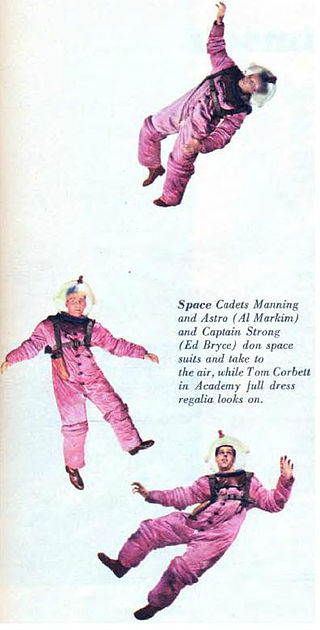
Tom Corbett, Space Cadet is a TV series that aired 1950–1955, depicting the fictional character Tom Corbett. Episodes were 15 minutes (weekdays) and 30 minutes (Saturdays).












